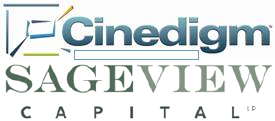World’s first non-commercial national digital cinema roll-out – June 26, 2009
“This is a great undertaking for a small country”, said Jorgen Stensland, Director of Consultants at Film & Kino. “Under these agreements, Disney, Fox, Paramount, Universal, and Warner have committed to deliver wide releases to Norwegian digital cinemas. The deal also covers our own mobile cinema in rural areas. Film & Kino’s goal of delivering quality film all over this country is secured in the future by these agreements. We are happy that Norwegians will be able to experience the perfect quality of a DCI-compliant digital exhibition, which will also give our audiences the opportunity to see the new generation of 3D films that are underway. We look forward to working together with the studios to make this happen.”
The agreements will help facilitate the financing of the conversion to digital cinema. The costs will be shared between distributors, cinemas and Film & Kino.
“A success like this is the result of a great team effort. We want to thank our team members for their unflagging commercial, technical and legal support during these negotiations”, said Roar Svartberg, Acting Director of Film & Kino.
Roger Pollock, Paramount Pictures’ Executive Vice President, International Distribution & Operations, said “Digital distribution and the growth of 3-D cinema is the future of our industry, enabling films to be seen in the highest quality and most dynamic ways possible. Film & Kino is aggressively stepping forward to place Norway at the forefront of this technology, providing their audiences with the very best movie-viewing experience available. This is an important step in Europe’s roll out to digital conversion and will hopefully serve as an influential example across the region.”
Julian Levin, Executive Vice President, Digital Exhibition, Twentieth Century Fox commented “We are delighted to have closed a deployment agreement with Film & Kino. This important deal is the first of its kind covering the conversion from 35mm film to DCI compliant digital projection for the entire country. The transition to a digital projection platform will additionally provide the foundation for 3D exhibition capability, exhibition of alternative content and improved flexibility in distribution and exhibition operations. The ultimate beneficiary of the transition will be the movie going audience. We look forward to working with our colleagues at Film & Kino during the transition and providing Fox’s movies, in 2D and 3D, to Film & Kino digital projection system deployments.”
Duncan Clark, Executive VP, International Distribution, Universal Pictures International, said: “We’re pleased to be working with Film & Kino to help the Norwegian cinema industry transition to digital cinema via our UIP territorial office in Norway. Clearly the growth of 3-D cinema and digital distribution is the future of our business and this complete rollout of digital to Norway’s cinemas, which has the backing of the Norwegian government, is an important step. Norway is the latest country to become part of the extensive conversion to digital that is being rolled out to cinemas in Europe. By supplying our movies digitally, we hope audiences in Norway as early as later this year, will soon be able to experience the highest quality cinema experience via the best digital technology available.”
Commenting on the announcement, Jason Brenek, senior vice president, Worldwide Digital Cinema and Cinema Programming, Walt Disney Studios Motion Pictures, said, “Digital cinema is taking a giant leap forward in Norway thanks to the tremendous efforts of Film & Kino. This is a bold and exciting move to transform all of Norway’s theaters to state-of-the-art DCI-compliant equipment and give moviegoers the best possible theatrical experience. Disney remains committed to digital cinema and digital 3D, and will continue to work with Film & Kino to bring the future of exhibition to moviegoers in a timely and cost effective manner. Our lineup of upcoming films includes a wide variety of titles that showcase this latest digital technology, including many films presented in Disney Digital 3D™.”
“Veronika Kwan-Rubinek, President, International Distribution, from Warner Brothers said, “Warner Bros. is excited about this unique partnership with Film & Kino, the first-ever deployment model that aims to digitize an entire country. This holistic transition to DCI compliant digital projection systems firmly establishes Norway as a leader in technological innovation and ensures the continued growth of this robust theatrical market.”





